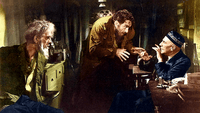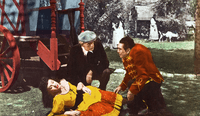The House of Frankenstein
The House of Frankenstein is a 1944 American monster crossover horror film starring Boris Karloff and Lon Chaney Jr., directed by Erle C. Kenton, written by Curt Siodmak, and produced by Universal Studios as a sequel to Frankenstein Meets the Wolf Man and Son of Dracula the previous year. The cast includes a mad scientist (Karloff), the Wolf Man (Chaney), Count Dracula (John Carradine), a hunchback (J. Carrol Naish), and Frankenstein's monster (Glenn Strange). This "monster rally" approach would continue in the following film, House of Dracula, as well as the 1948 comedy Abbott and Costello Meet Frankenstein.[3]
| The House of Frankenstein | |
|---|---|
 Theatrical release poster | |
| Directed by | Erle C. Kenton |
| Produced by | Paul Malvern |
| Screenplay by | Edward T. Lowe |
| Story by | Curt Siodmak |
| Starring | |
| Music by | |
| Cinematography | George Robinson |
| Edited by | Philip Cahn |
| Distributed by | Universal Studios |
Release date |
|
Running time | 71 minutes |
| Country | United States |
| Language | English |
| Budget | $354,000[2] |
Plot
Dr. Gustav Niemann (Boris Karloff) escapes from prison along with his hunchbacked assistant Daniel (J. Carrol Naish), for whom he promises to create a new, beautiful body. The two murder Professor Lampini (George Zucco), a traveling showman, and take over his horror exhibit.[4] To exact revenge on Bürgermeister Hussman (Sig Ruman), who had put him in prison, Niemann revives Count Dracula (John Carradine). Dracula seduces Hussmann's granddaughter-in-law Rita (Anne Gwynne) and kills Hussmann himself, but in a subsequent chase, Niemann disposes of Dracula's coffin, causing the vampire to perish in the sunlight.
Niemann and Daniel move on to the flooded ruins of Castle Frankenstein, where they find the bodies of Frankenstein's monster (Glenn Strange) and Lawrence Talbot, the Wolf Man (Lon Chaney Jr.), preserved in the frozen castle. Niemann thaws them and promises to find Talbot a cure for the curse. However, he is more interested in reviving the monster and exacting revenge on two traitorous former associates than in keeping his promises. Talbot transforms into a werewolf and kills a man, sending the villagers into a panic.
Niemann and Daniel save a gypsy girl named Ilonka (Elena Verdugo), and Daniel falls in love with her; it is unrequited, however, as Ilonka falls in love with Talbot. Daniel tells Ilonka that Talbot is a werewolf, but she is undeterred, and promises Talbot that she will help him.
Events reach a crisis point when Niemann revives the monster and Talbot again turns into a werewolf. The werewolf attacks and fatally wounds Illonka, but she manages to shoot and kill Talbot with a silver bullet before she dies. Daniel blames Niemann and turns on him. The monster intervenes, throws Daniel out of the window, and carries the half-conscious Niemann outside, where the villagers chase them into the marshes. There, both the monster and Niemann drown in quicksand.
Cast
- Boris Karloff as Dr. Gustav Niemann
- Lon Chaney Jr. as Lawrence "Larry" Talbot / The Wolf Man (billed as "Lon Chaney")
- J. Carrol Naish as Daniel
- John Carradine as Count Dracula
- Glenn Strange as Frankenstein's Monster
- Elena Verdugo as Ilonka
- Anne Gwynne as Rita Hussman
- Peter Coe as Karl Hussman
- Lionel Atwill as Inspector Arnz
- Sig Ruman as Bürgermeister Hussman
- George Zucco as Bruno Lampini
- William Edmunds as Fejos
- Charles F. Miller as Tobermann
- Philip Van Zandt as Müller
- Julius Tannen as Hertz
- Hans Herbert as Meier
- Dick Dickinson as Born
- Michael Mark as Strauss
Production
Frankenstein Meets the Wolf Man (1943) had been the first on-screen pairing of two Universal Studios monsters, but The House of Frankenstein was the first multi-monster movie. Early drafts of the story reportedly involved more characters from the Universal stable, including the Mummy, the Ape Woman, the Mad Ghoul, and possibly the Invisible Man. Working titles—which included Chamber of Horrors (a reference to Lampini's travelling horror show) and The Devil's Brood—emphasized the multi-monster nature of the story.
The multi-monster approach, which emphasized box office appeal over continuity, was used in House of Dracula the following year and later in Abbott and Costello Meet Frankenstein. The House of Frankenstein marked Glenn Strange's debut as the monster. Strange, a former cowboy, had been a minor supporting player in dozens of low-budget Westerns over the preceding 15 years. He reprised the role in House of Dracula and Abbott and Costello Meet Frankenstein, and cemented the popular image of the monster as shambling, clumsy, and inarticulate. Boris Karloff, who had moved on from playing the monster to playing the mad scientist, reportedly coached Strange on how to play the role.
The scream that accompanies Daniel's fall from the roof is actually the voice of Karloff, recycled from the scene in Son of Frankenstein where the monster howls in anguish at finding Ygor dead. The face on the monster dummy used in the ice and laboratory scenes was a mask of Lon Chaney Jr., who had played the monster himself in The Ghost of Frankenstein.
Strange did his own stunt work on the film, notably in the climax where he flees across a field of burning grass and sinks into a pool of quicksand. The grass was actually tumbleweeds, which nearly scorched him when they burned more quickly than expected. Stuntman Cary Loftin doubled for Boris Karloff in the fire scenes, but Karloff returned for the final scene in the quicksand.
Some continuity errors are evident in the finished film. After Dracula is thrown from the carriage, he looks over to where his coffin has landed; in a close-up, part of his mustache is gone. Also, when Talbot transforms into the Wolf Man for the final time, his hands lack fur.
Karloff's performance in this film is his last in Universal's classic horror cycle.[5]
Reception
A. H. Weiler of The New York Times compared the film's collection of monsters to "a baseball team with nine Babe Ruths, only this grisly congress doesn't hit hard; it merely has speed and a change of pace. As such, then, it is bound to garner as many chuckles as it does chills. However, lampoon or no, put this item down as a bargain for the bogie hunters."[6] Variety called it "a solid entry for the attention of the horror addicts" and called Naish "particularly well cast".[7] Harrison's Reports called it "only a mild horror picture, more ludicrous than terrifying. The whole thing is a rehash of the fantastic doings of these characters in previous pictures and, since they do exactly what is expected of them, the spectator is neither shocked nor chilled."[8]
See also
References
- Scivally, Bruce (2015). Dracula FAQ: All That's Left to Know About the Count from Transylvania (ebook). Backbeat Books. ISBN 9781617136368.
- Brunas, Michael; Brunas, John and Weaver, Tom (1980) Universal Horrors: The Studios Classic Films, 1931–46. McFarland. p.468
- Jacobs, Stephen. (2011) Boris Karloff: More Than a Monster. Tomahawk Press. p.291-96
- Rovin, Jeff (1987). The Encyclopedia of Supervillains. New York: Facts on File. p. 96. ISBN 0-8160-1356-X.
- Vieira, Mark A. (2003). Hollywood Horror: From Gothic to Cosmic. New York: Harry N. Abrams. p. 101. ISBN 0-8109-4535-5.
- Weiler, A.H. (December 16, 1944). "Movie Review – House of Frankenstein". The New York Times. Retrieved February 28, 2016.
- "Film Reviews". Variety. New York: Variety, Inc.: 17 December 20, 1944.
- "'House of Frankenstein' with Boris Karloff and Lon Chaney". Harrison's Reports: 207. December 23, 1944.
External links
| Wikimedia Commons has media related to House of Frankenstein (film). |
| Wikiquote has quotations related to: The House of Frankenstein |
.jpg)

